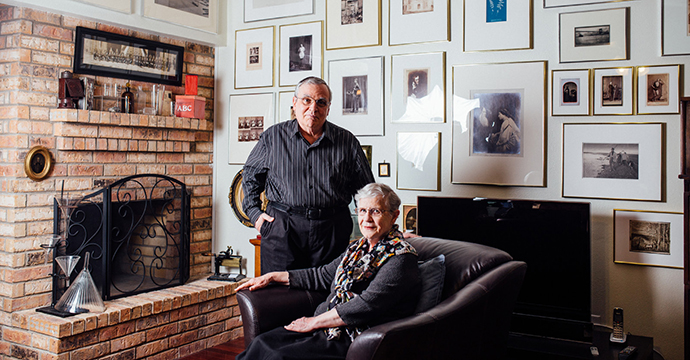The home of Lake Highlands residents Jack and Beverly Wilgus is like a shrine to photography.
It resembles a mixture of a museum, an old-timey general store and your grandma’s house. Various collections of knickknacks and vintage cameras are arranged neatly inside display cases; others are lined up along tables or shelves. Black-and-white photographs cover every inch of wall space.
When house shopping, the couple specifically requested a home with plenty of white wall space and as little natural lighting as possible. It’s an odd request, but they needed dark spaces in which to hang their extensive vintage photography collection — and that doesn’t even include the boxes upon boxes of work they have stacked floor-to-ceiling in the extra bedroom.
“We collect everything photographic or connected with the history of photography,” Beverly says. “When you have 100-something-thousand, probably more, it’s hard to find something when you need it.”
But they managed to select a portion of their collection to display at the DeGolyer Library at Southern Methodist University for the exhibition “Defined by Light: Photography’s First 75 Years,” which ran through December in celebration of the 175th anniversary of the announcement of photography.
The Wilguses have spent their lives collecting photographic treasures. The history of photography fascinates them, and it’s what brought them together many years ago when they both worked at the Art Institute of Chicago.
“Photography is one of those mediums that touches on everything,” Jack explains. “So if you’re interested in anything, you can find images that excite you. What interests us is history, the photographers who were doing significant work at their time.”
Over the years, the Wilguses have managed to find and acquire pieces by some of the world’s earliest photographers, such as Julia Margaret Cameron, Francis Frith and Francis Bedford.
They collect various photographic niches — from post-mortem and memorial photography to spirit photography — as well as hundreds of vintage cameras and camera-themed trinkets.
They even have several versions of the camera obscura, which is what artists used to project images onto a screen in order to sketch them.
“We wanted to collect something that was more than just an accumulation,” Beverly says. “We don’t buy stuff we don’t like, but we wanted something that showed the progression from the beginning of photography all the way up to the 21st century.”






